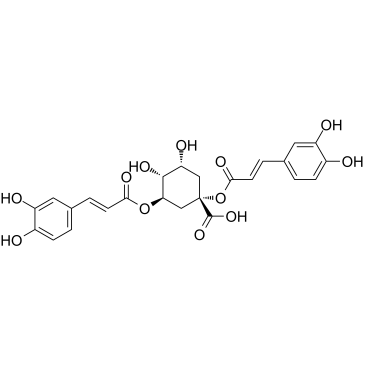1,3-Dicaffeoylquinic acid (Synonyms: 1,5-DCQA, 1,3-Dicaffeoylquinic Acid) |
| Catalog No.GC35037 |
1,3-Dicaffeoylquinic acid is a caffeoylquinic acid derivative, and activates PI3K/Akt.
Products are for research use only. Not for human use. We do not sell to patients.

Cas No.: 19870-46-3
Sample solution is provided at 25 µL, 10mM.
1,3-Dicaffeoylquinic acid is a caffeoylquinic acid derivative that exhibits antioxidant activity and radical scavenging activity. Akt PI3K
1,3-Dicaffeoylquinic acid shows increased neuronal cell viability against Aβ(42) toxicity in a concentration-dependent manner in neurons. 1,3-Dicaffeoylquinic acid activates both phosphoinositide 3-kinase (PI3K)/Akt and extracellular regulated protein kinase 1/2 (Erk1/2) with stimulating their upstream tyrosine kinase A (Trk A). 1,3-Dicaffeoylquinic acid's anti-apoptotic potential is related to the enhanced inactivating phosphorylation of glycogen synthase kinase 3β (GSK3β) and the modulation of expression of apoptosis-related protein Bcl-2/Bax[2]. 1,3-Dicaffeoylquinic acid (10 μM, 20 μM, 50 μM, and 100 μM) significantly increases cell viablity before OGD/reperfusion, and prevents the depletion of GSH under OGD/reperfusion insult. 1,3-Dicaffeoylquinic acid induces nuclear translocation of Nrf2 in OGD/reperfusion treated astrocytes, and induces increased GCL activity, and the effect is lost in Nrf2 siRNA-transfected cells[3].
1,3-Dicaffeoylquinic acid (32.0 mg/kg, p.o.) and 1-O-ABL are absorbed very quickly in Wistar rats. The maximum plasma concentrations for 1,3-Dicaffeoylquinic acid and 1-O-ABL are 44.5 ± 7.1 and 19.1 ± 6.9 ng/mL, respectively[1].
[1]. Wang Z, et al. An LC-MS/MS method for simultaneous determination of 1,5-dicaffeoylquinic acid and 1-O-acetylbritannilactone in rat plasma and its application to a pharmacokinetic study. [2]. Xiao HB, et al. 1,5-dicaffeoylquinic acid protects primary neurons from amyloid β 1-42-induced apoptosis via PI3K/Akt signaling pathway. Chin Med J (Engl). 2011 Sep;124(17):2628-35. [3]. Cao X, et al. 1, 5-Dicaffeoylquinic acid-mediated glutathione synthesis through activation of Nrf2 protects against OGD/reperfusion-induced oxidative stress in astrocytes. Brain Res. 2010 Aug 6;1347:142-8.
Average Rating: 5 (Based on Reviews and 13 reference(s) in Google Scholar.)
GLPBIO products are for RESEARCH USE ONLY. Please make sure your review or question is research based.
Required fields are marked with *




















